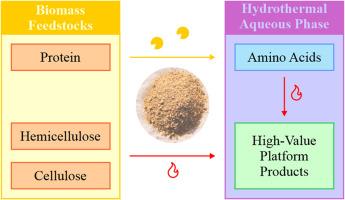Conversion of high-value products from biomass aqueous phase through enzymatic-hydrothermal treatment
IF 5.8
2区 生物学
Q1 AGRICULTURAL ENGINEERING
引用次数: 0
Abstract
Hydrothermal treatment is a beneficial method for the resource utilization of biomass waste, producing hydrochar and an aqueous phase containing valuable organic products. However, the pathway for recovering high-value products from the aqueous phase remain insufficiently explored. This work presents an innovative enzymatic-hydrothermal treatment designed to enrich the concentration of nitrogen-containing compounds in the hydrothermal aqueous phase (AP) derived from nitrogen-rich biomass. A detailed analysis of the post-enzymatic AP products was carried out, with a specific emphasis on tracking changes in the chemical composition of the AP. The results showed a significant increase in the nitrogen content of the soymeal-derived AP after enzymatic pre-treatment followed by hydrothermal treatment at 220 °C. Meanwhile, valuable platform compounds such as furfural and 5-hydroxymethylfurfural were produced via isophorone-catalyzed decarboxylation of α-amino acids within the enzymatic soymeal AP, steered by deliberate modifications in the reaction pathway. Moreover, a working mechanism for this catalytic decarboxylation process was proposed, enabling precise adjustments to the composition of the AP.

通过酶-水热处理生物质水相转化高价值产品
水热处理是生物质废弃物资源化利用的一种有益方法,可产生烃类和含有有价值有机产物的水相。然而,从水相中回收高价值产品的途径仍然没有得到充分的探索。这项工作提出了一种创新的酶-水热处理方法,旨在提高富氮生物质水热相(AP)中含氮化合物的浓度。对酶解后的AP产物进行了详细的分析,重点跟踪了AP化学成分的变化。结果表明,酶解预处理后再进行220°C水热处理后,大豆源AP的氮含量显著增加。同时,有价值的平台化合物如糠醛和5-羟甲基糠醛是通过在酶促豆粕AP中异福尔酮催化α-氨基酸脱羧而产生的,并在反应途径中进行刻意修饰。此外,还提出了该催化脱羧过程的工作机制,从而可以精确调节AP的组成。
本文章由计算机程序翻译,如有差异,请以英文原文为准。
求助全文
约1分钟内获得全文
求助全文
来源期刊

Biomass & Bioenergy
工程技术-能源与燃料
CiteScore
11.50
自引率
3.30%
发文量
258
审稿时长
60 days
期刊介绍:
Biomass & Bioenergy is an international journal publishing original research papers and short communications, review articles and case studies on biological resources, chemical and biological processes, and biomass products for new renewable sources of energy and materials.
The scope of the journal extends to the environmental, management and economic aspects of biomass and bioenergy.
Key areas covered by the journal:
• Biomass: sources, energy crop production processes, genetic improvements, composition. Please note that research on these biomass subjects must be linked directly to bioenergy generation.
• Biological Residues: residues/rests from agricultural production, forestry and plantations (palm, sugar etc), processing industries, and municipal sources (MSW). Papers on the use of biomass residues through innovative processes/technological novelty and/or consideration of feedstock/system sustainability (or unsustainability) are welcomed. However waste treatment processes and pollution control or mitigation which are only tangentially related to bioenergy are not in the scope of the journal, as they are more suited to publications in the environmental arena. Papers that describe conventional waste streams (ie well described in existing literature) that do not empirically address ''new'' added value from the process are not suitable for submission to the journal.
• Bioenergy Processes: fermentations, thermochemical conversions, liquid and gaseous fuels, and petrochemical substitutes
• Bioenergy Utilization: direct combustion, gasification, electricity production, chemical processes, and by-product remediation
• Biomass and the Environment: carbon cycle, the net energy efficiency of bioenergy systems, assessment of sustainability, and biodiversity issues.
 求助内容:
求助内容: 应助结果提醒方式:
应助结果提醒方式:


